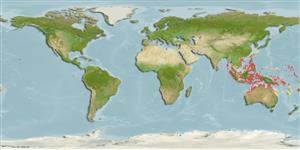>
Blenniiformes (Blennies) >
Tripterygiidae (Triplefin blennies) > Tripterygiinae
Etymology: Helcogramma: Greek, helkos, -eos, -ous = ulcer, sore + Greek, gramma = letter, mark (Ref. 45335).
Environment: milieu / climate zone / depth range / distribution range
ນິເວດວິທະຍາ
ສັດທະເລ ກ່ຽວກັນຫີນ; ລະດັບຄວາມເລິກ 0 - 12 m (Ref. 90102), usually 3 - 10 m (Ref. 13227). Tropical
Western Pacific: Philippines, Indonesia, New Guinea, Vanuatu, Australia, and the Solomon Islands.
ຂະໜາດ / ນ້ຳໜັກ / Age
Maturity: Lm ? range ? - ? cm
Max length : 3.4 cm SL ຕົວຜູ້/ບໍ່ມີເພດ; (Ref. 13227)
ຄີ (ໜາມ)ແຂງຢູ່ຫຼັງປາ (ທັງໝົດ): 14 - 17; ຄີຫຼັງຂອງປາ (ຄີອ່ອນ) (ທັງໝົດ): 8-12; ຄີ(ໜາມ) ແຂງຢູ່ຄີກົ້ນປາ
ກຸ່ມປາກະດູກແຂງ
ຄວາມຖີ່ຂອງກຸ່ມຖ່າຍທອດພັນ
ປາທີ່ມີການເຄື່ອນຍ້າຍຈາກທະເລໄປຫານ້ຳຈືດ ແລະນ້ຳຈືດຫາທະເລ
ປາທີ່ມີການເຄື່ອນຍ້າຍຈາກທະເລແລະໄປໄຂ່ຢູ່ນ້ຳຈືດ
ຄີກົ້ນຂອງປາ
ສັດທີ່ມີກະດູກສັນຫັຼງ
ການຖ່າຍທອດທາງກຳມະພັນຈາກພໍ່ແມ່ຫາລູກ 1; ຄີກົ້ນຂອງປາ: 18 - 22. Dorsal fin III + XI-XIV (usually XII), 8-12 (usually 11); anal fin I, 18-22 (usually 19); pectoral rays 17, ventral most 6-7 simple and thickened, dorsalmost ray simple, remainder branched; pelvic fin I,2, spines simple and embedded, rays simple and bound together with membrane. Lateral line continuous, pored scales 12-18 (usually 14), terminates under 7th-10th dorsal-fin elements; head, nape and narrow strip on upper back scaleless. Mandibular sensory pores 5-12 + 5-10 + 5-12 (usually 3 + 1- 2 + 3); nasal tentacle small and leaf-like; orbital cirri absent; cephalic sensory pores simple, dorsally and laterally not covered by bone (Ref. 6211, 90102). Overall transluscent grey; body vertical bars, six, reddish brown, may be branched dorsally; pectoral fin spot red; caudal fin margin red. Male masked on ventral half of head; dorsal fins with bands; caudal fin margin black (Ref. 90102). Measurements in %SL: head length 33.9 (32.9-35.7); eye diameter 11.3 (10.4-12.7); second dorsal-fin base 33.6 (30.7-35.7); third dorsal fin base 22.0 (19.3-23.3); anal-fin base 44.5 (42.8-46.7); distance PI-anal fin 21.8 (18.9-24.5); first dorsal-fin spine 14.8 (12.2-17.4); longest second dorsal-fin spine 16.1 (14.4-17.1); longest third dorsal-fin segmented ray 15.0 (13.7-15.8); seventh pectoral-fin ray 29.3 (27.4-32.0); upper jaw length 15.9 (14.7-17.5); longest pelvic fin ray 24.4 (21.1-27.0) (Ref. 6211).
Adults live on rock surfaces and under ledges, commonly at depths less than 10 m (Ref. 13227). Eggs are hemispherical and covered with numerous sticky threads that anchor them in the algae on the nesting sites (Ref. 240). Larvae are planktonic which occur primarily in shallow, nearshore waters (Ref. 94114).
Life cycle and mating behavior
ການຈະເລີນເຕັມໄວ | ການສືບພັນ | ການວາງໄຂ່ | ໄຂ່ | ຄວາມດົກຂອງໄຂ່ປາ | ຕົວອ່ອນ
Fricke, R., 1994. Tripterygiid fishes of Australia, New Zealand and the southwest Pacific Ocean (Teleostei). Theses Zool. 24:1-585. (Ref. 13227)
IUCN Red List Status (Ref. 130435)
Threat to humans
Harmless
Human uses
ການປະມົງ: ທີ່ບໍ່ມີຄວາມສົນໃຈ
ຂໍ້ມູນຕື່ມອີກ
ຊື່ສາມັນຄຳສັບຄ້າຍຄືກັນການເຜົາໃໝ້ພະລັງງານໂດຍປ່ຽນທາດອາຫານໃນຮ່າງກາຍໃຫ້ກາຍເປັນຊີ້ນແລະໜັງຜູ້ລ້າການສຶກສາຜົນກະທົບຂອງສານຜິດທີ່ມີຜົນກະທົບຕໍ່ລະບົບນິເວດການສືບພັນການຈະເລີນເຕັມໄວການວາງໄຂ່ການສັງລວມການວາງໄຂ່ຄວາມດົກຂອງໄຂ່ປາໄຂ່Egg development
ເອກະສານອ້າງອີງການລ້ຽງສັດນ້ຳຂໍ້ມູນການລ້ຽງສັດນ້ຳສາຍພັນກຳມະພັນElectrophoresesການຖ່າຍທອດທາງກຳມະພັນຈາກພໍ່ແມ່ຫາລູກພະຍາດການປຸງແຕ່ງNutrientsMass conversion
ຜູ້ຮ່ວມມືຮູບStamps, Coins Misc.ສຽງຫອຍມີພິດຊະນິດນຶ່ງທີ່ອາໄສໃນທະເລຄວາມໄວປະເພດການລອຍເນື້ອທີ່ເຫືອກOtolithsສະໝອງວິໄສທັດ
ເຄື່ອງມື
Special reports
Download XML
ແຫຼ່ງອີນເຕີເນັດ
Estimates based on models
Preferred temperature (Ref.
123201): 26.7 - 29.3, mean 28.7 °C (based on 1833 cells).
Phylogenetic diversity index (Ref.
82804): PD
50 = 0.5000 [Uniqueness, from 0.5 = low to 2.0 = high].
Bayesian length-weight: a=0.00562 (0.00258 - 0.01228), b=3.08 (2.89 - 3.27), in cm total length, based on LWR estimates for this (Sub)family-body shape (Ref.
93245).
ຊັ້ນເຂດຮ້ອນ (Ref.
69278): 3.0 ±0.3 se; based on size and trophs of closest relatives
ຄວາມຢືດຢຸ່ນ (Ref.
120179): ສູງ, ປະຊາກອນຕຳ່ສຸດທີ່ໃຊ້ເວລາສອງໜ້ອຍກວ່າ 15 ເດືອນ (Preliminary K or Fecundity.).
Fishing Vulnerability (Ref.
59153): Low vulnerability (10 of 100).
Nutrients (Ref.
124155): Calcium = 514 [190, 2,142] mg/100g; Iron = 2.76 [0.99, 6.44] mg/100g; Protein = 18 [16, 20] %; Omega3 = 0.0937 [, ] g/100g; Selenium = 56.8 [10.5, 256.4] μg/100g; VitaminA = 66.8 [9.7, 501.5] μg/100g; Zinc = 5.6 [2.4, 10.6] mg/100g (wet weight);
